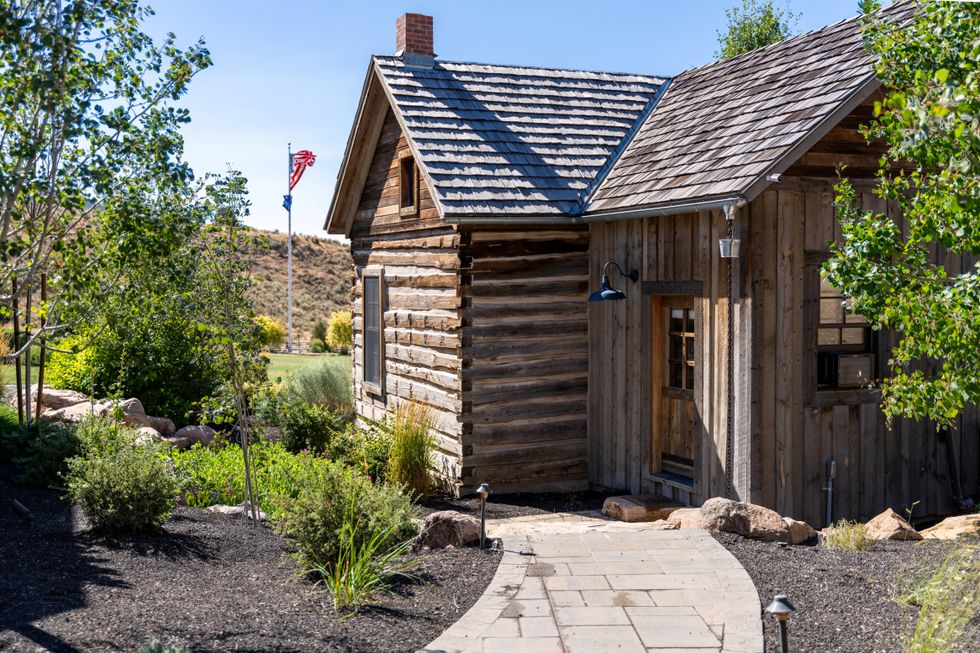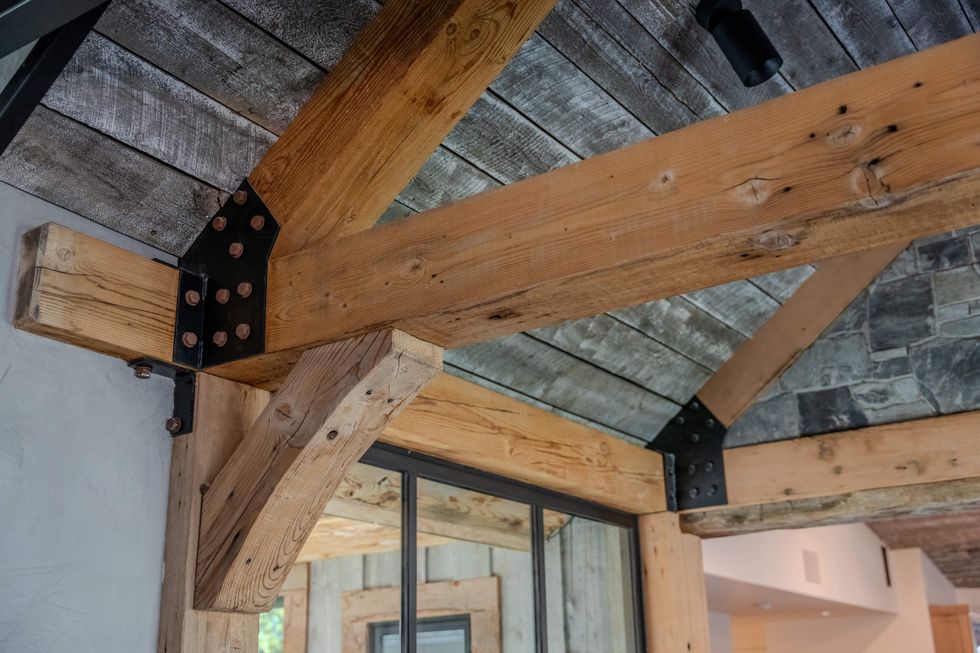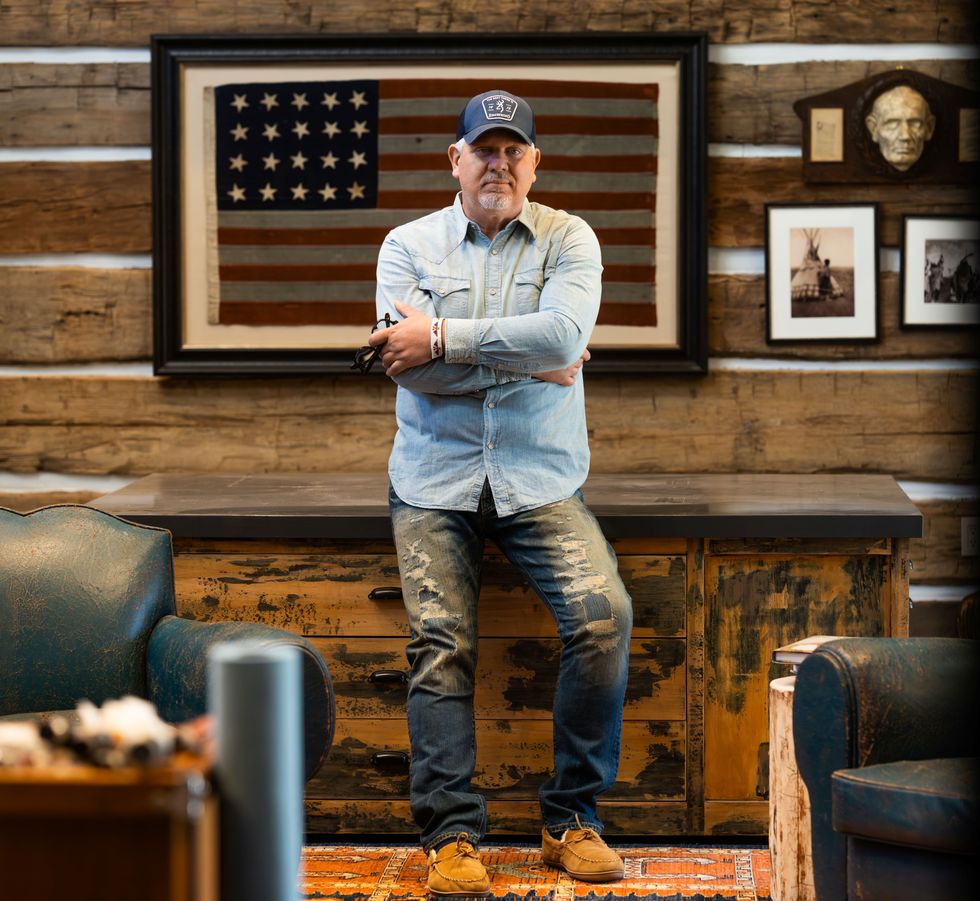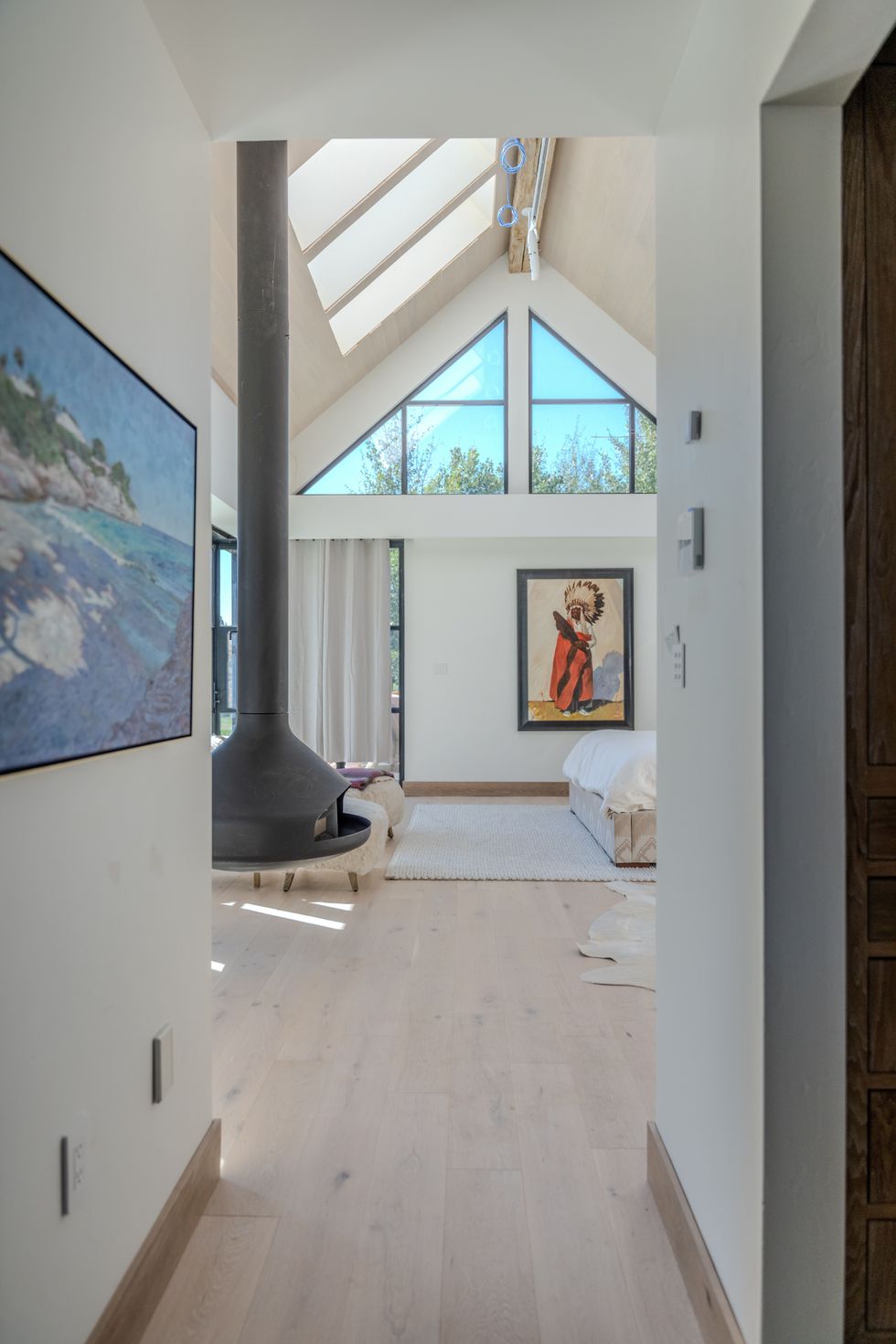
© 2025 Blaze Media LLC. All rights reserved.
Nestled in the majestic beauty of Idaho, a ranch was built to tell the story of Glenn Beck’s love of faith, family, and art.
“It is the solitude and freedom of the family home in the country which constantly preserves the purity of the nation and invigorates its intellectual powers.” A.J. Downing, The Architecture of Country Houses (1850)
The site was barren: a gravel road, an old log cabin, and a peculiar brick ranch house that seemed more suited to the suburbs of Bethesda, Maryland, than to this dry climate. The coarse breeze and the relentless sun felt contrary to establishing a lively family homestead. Yet, that was the challenge, and beneath his cowboy hat, a broad shadow cast across his face, Glenn looked at me with a clear vision in his eyes, contemplating how it might come to life.
He didn’t say much when I first arrived. It had been two years since we met in NYC, when a sketch of mine, created during his last episode on Fox, caught his producer’s attention. I was introduced to him as “the architect.” Now, with dozens of projects behind us, I was invited to meet him and his family at an old property he had just acquired out west, which he was looking to convert into a ranch. We saw only a small patch of arid land with hardly any life, except for barn swallows zipping overhead and curious black cattle on the hill staring back at us as we walked the site. Glenn looked down at his boots, kicked a bit of dirt on the dusty ground, looked up at the house under his bleached cowboy hat, turned to me, and said, “All I want is to build a house like my grandfather would have built”—one that would last a century or more.
A Clear Vision
It is challenging to grasp the immense responsibility of designing a house for someone else, even if you’ve undertaken the daunting endeavor before. The design must effectively reflect the values, personalities, traditions, and unique culture of the client and their family. Home, after all, embodies who we are. Most people don’t construct their homes. More often, homes are bought and decorated to showcase the things cherished by that family. However, when designing a home, the opportunity to express personal values can be woven into every design decision, from form and space to light switches and baseboards. When collaborating with someone like Glenn who is relentlessly mindful of details, every aspect of the home is considered because he knows each feature contributes to a larger narrative. At heart, Glenn is an expert storyteller, and the story we were about to write would be more of a creative collaboration and expression of shared values than a simple binary dialogue between client and architect.

Converting the property into a ranch started with renovating the existing brick home. My first thought mirrored what Glenn’s wife, Tania, was considering: “Tear it down and start over.” In hindsight, that might have been the better option! However, we didn’t want to waste the house’s solid construction or forfeit valuable time in creating a Western family outpost. Therefore, we decided to draw inspiration from the adjacent log cabin and wrap the ranch house in trestle wood planks. This wood came from the massive trestle bridge that once spanned the Great Salt Lake. It is prized for its rich color and the infused minerals from the lake, which provide great durability against rot and insects. The material would echo the cabin, giving the house the desired aged appearance, adding to its story while reflecting its regional history.

A common architectural feature found throughout the nearby community and highlighted in the renovation is the front porch. This space serves as a public gathering area before one enters the owner's private domicile. In the ranch renovation, we transformed a small concrete entry stoop into a spacious stage with a retract able window wall replacing the front door. What was once closed off has been reimagined as a broad opening where light, views, and exterior air blend with the coolness, shade, and security of the interior. The porch invites guests to sit and linger before entering the home. It’s where Glenn greets visitors, and it also serves as a place for him to address a crowd. We designed it to be accessible from three sides, with steps wide enough to double as tiered seating.
Home, after all, embodies who we are.
The original cabin also inspired the interior design, featuring natural materials throughout a spacious, open living space anchored by a stone fireplace with bedrooms on the outskirts. While the exterior was wrapped in wood, the interior boasted hand-hewn beams from a decommissioned Ohio barn, and all the doors were sourced from antique shops. These doors are unique, each one showcasing different styles with distressed finishes. Some date back 100 years and were salvaged from places like apothecary shops and one-room schoolhouses. Each door has its own story, and we brought these narratives together under one roof. At one point, a door arrived that Glenn had “a bad feeling" about. He didn’t want to know its backstory and certainly didn’t want it in the house. A feeling like that is hard to shake. So off it went to the firepit, where all its hidden histories were soon consumed in the hungry flames.
The doors were an integral part of the design strategy. We aimed for the house to feel aged, as if it had been built over time. Yet we also wanted it to feel fresh and livable. It needed to reflect the values of the past, where honor, simplicity, and hard work were evident in every aspect of the design. The open kitchen defied prevailing trends by blending various styles, colors, and finishes. The cathedral ceiling was clad in weathered, whitewashed barn wood. The doorknobs on the reclaimed doors were an assortment of glass, metal, and ceramic. Even the light switches were selected for their vintage, push-button mechanisms. This choice added a tactile element to a routine task, so even the act of turning the lights on and off became a reenactment of days gone by.
Building a Narrative
Everything Glenn designs evokes an authentic narrative. It’s not enough to simply see something; he wants people to experience it. This holds true in his broadcasts, paintings, and writings. When we first met, we strolled around New York City, and he explained to me the embedded stories of Rockefeller Center and the ornate detailing of the original GE building. He presented New York as a collection of stories in built form. This aesthetic is what the ranch was destined to become: a narrative for generations to read and ultimately to contribute to shaping the new addition.

When we first met onsite to discuss the addition in 2020, we took on the role of surveyors. Tania held the stick with the scale, I measured, and Glenn kept the line level and the string taut as we plotted points along an improvised armature. Using this method, we mapped several usable profiles and I translated these measurements in the studio, comparing them to a larger site survey. We marked the extent of the addition on the grass with spray paint, and it quickly became clear to us that half the hill would need to be removed if we were going to fit everything onto the site. This Herculean task soon commenced while the design was being finalized. Glenn even got a chance to drive the front loaders, only delaying the project by a day or two.
A challenge to the design of the addition was scaling the structure to accommodate large groups while also keeping it subtle enough not to dominate the landscape or rise so high that it overshadowed the original house.

The house seems to avoid technology with its abundance of raw materials and exposed structure. However, concealed within its walls are 32 miles of wiring that powers and supports cutting-edge automation, from A/V systems throughout the home to roller shades and advanced security features.
A Dream Brought to Life
The new addition serves several purposes. Glenn and Tania required an art studio for his paintings and her quilting work. They sought a space to create, along with a library to house their extensive collection of books and historical artifacts. An exercise room and a bunk room for their kids and grandkids were also essential. The primary aim of the addition, however, was to create a truly great room that serves as the hall mark of the ranch and the main gathering space of the house, where family, friends, and guests can come together under a spacious canopy and still feel connected to the surrounding landscape.
Once inside, the focal point of the space shifted to the fireplace. If the porch is the face of the house, the fireplace is its heart. Traditionally, the fireplace symbolizes the connectivity of family, gathering around the primary vertical axis of the home that links the earth to the heavens. In indigenous structures of the American West, and often around the world, buildings with openings to the sky serve two purposes. As anthropologist Mircea Eliade discusses in The Sacred and the Profane, these openings toward the sky enable our spirits to rise while simultaneously allowing the heavens to descend along what Eliade refers to as an axis mundi. This concept was a primary motivator in the renovation, and more significantly in the new addition, as the original structure was removed to create a broad channel of space connecting the interior and exterior, directing attention to the voluminous space in the living room beyond.
When designing a home, the opportunity to express personal values can be integrated into every design decision, from form and space to light switches and baseboards.
Originally inspired by Citizen Kane, the fireplace rises from the floor and rests on a large stone hearth, with the stone chimney stack stretching upward 25 feet, clad in stone, and subtly tapered to enhance its height. The hearth extends so prominently into the living space that the builder was uncertain about the generous proportions depicted in the drawings, prompting him to call me for confirmation. It had to be explained that the hearth serves as a stage in the living room, aligning with Glenn's vision. Like the front porch, it is also equipped with wiring for microphones and cameras.
Inscribed on the fireplace mantel is a beam from a cabin originally built by a freed slave who moved west. This beam carries a Latin phrase also inscribed atop the aluminum cap of the Washington Monument: Laus Deo (Praise to God). It’s no coincidence that the same phrase appears at the apex of a monumental structure honoring our greatest citizen and is also engraved into the remnant of a humble dwelling belonging to a man whose name has faded from history. Both men sought freedom; both men persevered; both men are equal and cherished in the eyes of God. They both harbored dreams in their hearts, and ultimately, they both fulfilled God’s purpose.
A Multipurpose Monument
The great room serves another function as well. While designed for entertainment and comfort, the space is devoted to service and is meant to communicate Glenn and Tania’s faith. Eliade writes at length about the sacred role the home plays in culture and the family. The home, he explains, is a small fragment of the cosmos. It is a place where we gather under a piece of the sky (the roof) to be protected from the elements and to step away from the profane (the world) and into the arms of the sacred (the family) in the shelter of our dwelling (the home).
The space is washed in light from the surrounding glass walls to the elevated monitor windows that frame beams of light over the low, sloped ceiling. In the floor, at the link connecting the renovated original home to the newly expanded addition, “Proverbs 19:21” is engraved into a block of stone selected from the original quarry of King Solomon. The proverb reads, “Many are the plans in a man’s heart; but it is the Lord’s purpose that prevails.”
Glenn also wanted the space to serve a greater purpose. “If needed,” he asked me, “can it be converted to a hospital or shelter?” With this directive, the space was designed to accommodate rows of beds with ample room for equipment. We have created an open space—abundant in light and shaped in faith—that invites discussion, community, and, if needed, can indeed convert into a shelter or hospital.
The Standing Rock Ranch is named after a natural monument in the nearby valley. A towering rock, dislodged by some extraordinary event from the rocky ridge hundreds of feet above, now impales the earth, resolute and enduring against relentless conditions. The ranch symbolizes independence and endurance. It serves as both a retreat and a shelter. While the early settlers could not have imagined that a home like this could exist in the barren world they traversed, they would appreciate the significance of a space shaped by the eternal bonds of family, the strength found in community, and the ultimate freedom found in faith.
The story of Standing Rock Ranch continues to be written in the memories of all who share comfort, delight, and purpose in this place. Like its namesake, the ranch and its story will, with faith and wonder, endure.
Rob Petrie, AIA, is an architect, designer, and illustrator. He has worked across the country and taught architecture and drawing at several universities. A graduate of VA Tech and Cornell, he now manages his own practice and lives with his wife, four kids and flock of ducks in upstate NY.
Want to leave a tip?
We answer to you. Help keep our content free of advertisers and big tech censorship by leaving a tip today.
Want to join the conversation?
Already a subscriber?
more stories
© 2025 Blaze Media LLC. All rights reserved.
Get the stories that matter most delivered directly to your inbox.
By signing up, you agree to our Privacy Policy and Terms of Use, and agree to receive content that may sometimes include advertisements. You may opt out at any time.


